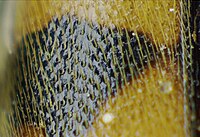Spot-binding neck buck
| Spot-binding neck buck | ||||||||||||
|---|---|---|---|---|---|---|---|---|---|---|---|---|

Spotted neck buck |
||||||||||||
| Systematics | ||||||||||||
|
||||||||||||
| Scientific name | ||||||||||||
| Pachytodes erraticus | ||||||||||||
| ( Dalman , 1817) |
The spot cohesive neck Bock ( Pachytodes erraticus ) is a beetle from the family of longhorn beetles . The name Judolia erratica is also used for this species, which is rare in Central Europe . The beetle resembles the much more common spotted flower buck .
The species is listed in the Red List of Endangered Species in Germany under category 0 (extinct or lost).
Comments on the name and system
The species was first described in 1817 by the Swede Dalman under the name Leptura erratica . The species name "erraticus" ( Latin ) means wandering .
The genus name Pachytodes means "similar to the genus Pachyta" ( old Greek ειδής eidēs, similar), the name Pachyta from old Greek. παχύτης pachýtes, derived from thick. The name was chosen by Pic in 1891 when he separated Pachytodes from the genus Judolia due to the distinction between "Body more or less rounded" and "Body slightly elongated" ( en. Body more or less rounded or body slightly elongated ) . This separation is not generally recognized when considering non-European species that stand between Judolia (see p.) And Pachytodes.
In Europe, the genus Pachytodes is only represented by Pachytodes cerambyciformis , apart from the spotted neck buck .
Characteristics of the beetle
The beetle reaches a length of seven to twelve millimeters. The body is black, the wing-coverts white-yellowish with black spots and bands. The bandages can be dissolved in spots or the spots fused to form bandages (taxo image and Fig. 1). The insect has sparsely light hair, the hair is slightly protruding and thickens in front of the tag . The body is short, the wing-coverts about twice as long as together wide.
The head is tilted at an angle. It narrows behind the eyes . The cheeks are well developed. The eyes are kidney-shaped and well separated from the back of the head. The antennae arise in the edges of the eyes. They are eleven-limbed, thread-shaped, but relatively short for longhorn beetles.
The pronotum is bell-shaped and deeply and broadly indented on both sides in front of the rear edge, but not in front of the shield. In contrast to the spotted cone, the wing covers are not matt, but slightly shiny (picture 1 and picture 2). In addition, the puncture of the elytra is less dense in the spotted neckbuck. The wing top seam is black. In addition, the wing covers have three black cross bars, of which the foremost is usually interrupted. The drawing is very variable, the wing covers can also be completely black.
The five-part tarsi are apparently four-part (pseudotetrameric), as the very small fourth tarsi is hidden at the base of the lobed third tarsi (Fig. 4, green line). In contrast to the spotted cone, the third tarsal link is only split by about a third (Fig. 3 and 4, division line in the black bar).
biology
The warmth-loving species occurs in Central Europe only in warm areas and is there restricted to forests and bushy slopes. The larva develops in dead underground parts of various deciduous trees ( oak , birch , maple , hazel and others). It takes two years to develop. The adult beetle appears from June to August. They can then be found on dry twigs and on various flowers ( hogweed , yarrow , chrysanthemums ).
distribution
The center of the distribution area of the species lies in southern and southeastern Europe. However, the beetle has a wide range. There are reports of finds from Spain to northern Iran.
literature
- Heinz joy, Karl Wilhelm Harde, Gustav Adolf Lohse (ed.): The beetles of Central Europe . tape 9 . Cerambycidae Chrysomelidae . Spektrum Akademischer Verlag, Munich 1999, ISBN 3-8274-0683-8 (first edition: Goecke & Evers, Krefeld 1966).
- Adolf Horion : Faunistics of the Central European Beetles, Bd. XII . Überlingen-Bodensee 1974
- Klaus Koch : The Beetles of Central Europe . Ed .: Heinz Freude . tape 3 : ecology . Goecke & Evers, Krefeld 1992, ISBN 3-87263-042-3 .
Individual evidence
- ↑ Red lists at BioNetworkX
- ↑ Sigmund Schenkling: Explanation of the scientific beetle names (species)
- ↑ Sigmund Schenkling: Explanation of the scientific beetle names (genus)
- ↑ Hüseyin Özdikmen: A PROPOSE FOR ACCEPTION OF A SINGLE GENUS AS JUDOLIA MULSANT, 1863 INSTEAD OF THE GENERA JUDOLIA MULSANT, 1863 AND PACHYTODES PIC, 1891 (COLEOPTERA: CERAMBYCIDAE: LEPTURINIE: Mun. Ent. Zool. Vol 6., No 2, June 2011, pp. 900 ff as PDF ( page no longer available , search in web archives ) Info: The link was automatically marked as defective. Please check the link according to the instructions and then remove this notice.
- ↑ Pachytodes in Fauna Europaea. Retrieved February 27, 2013
- ^ Systematics and distribution area of Pachytodes erraticus in Fauna Europaea




